Related Research Articles
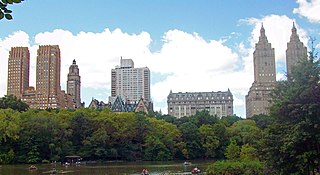
A housing cooperative, or housing co-op, is a legal entity, usually a cooperative or a corporation, which owns real estate, consisting of one or more residential buildings; it is one type of housing tenure. Typically housing cooperatives are owned by shareholders but in some cases they can be owned by a non-profit organization. They are a distinctive form of home ownership that have many characteristics that differ from other residential arrangements such as single family home ownership, condominiums and renting.

Co-op City is a cooperative housing development located in the northeast section of the borough of the Bronx in New York City. It is bounded by Interstate 95 to the southwest, west, and north and the Hutchinson River Parkway to the east and southeast, and is partially in the Baychester and Eastchester neighborhoods. With 43,752 residents as of the 2010 United States Census, it is the largest housing cooperative in the world. It is in New York City Council District 12.

Park La Brea is an apartment community in the Miracle Mile District of Los Angeles, California. With 4,255 units located in eighteen 13-story towers and thirty-one two-story buildings, it is among the largest apartment complexes in the continental United States. It sits on 160 acres (0.65 km2) of land.
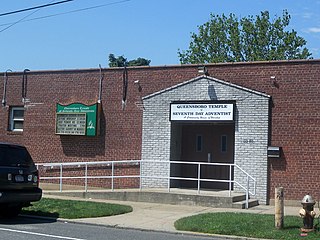
South Jamaica is a residential neighborhood in the borough of Queens in New York City, located south of downtown Jamaica. Although a proper border has not been established, the neighborhood is a subsection of greater Jamaica bounded by the Long Island Rail Road Main Line tracks, Jamaica Avenue, or Liberty Avenue to the north; the Van Wyck Expressway on the west; Rockaway Boulevard on the south; and Merrick Boulevard on the east, adjoining the neighboring community of St. Albans. Other primary thoroughfares of South Jamaica include Baisley, Foch, Linden, Guy R. Brewer, and Sutphin Boulevards. The 180th Street Business Improvement District is responsible for the development of the area.

LeFrak City is a 4,605-apartment development in the southernmost region of Corona and the easternmost part of Elmhurst, a neighborhood in the New York City borough of Queens. It is located between Junction Boulevard to the west, 57th Avenue to the north, 99th Street to the east, and the Long Island Expressway to the south.
The United Kingdom is home to a widespread and diverse co-operative movement, with over 7,000 registered co-operatives owned by 17 million individual members and which contribute £34bn a year to the British economy. Modern co-operation started with the Rochdale Pioneers' shop in the northern English town of Rochdale in 1844, though the history of co-operation in Britain can be traced back to before 1800. The British co-operative movement is most commonly associated with The Co-operative brand which has been adopted by several large consumers' co-operative societies; however, there are many thousands of registered co-operative businesses operating in the UK. Alongside these consumers' co-operatives, there exist many prominent agricultural co-operatives (621), co-operative housing providers (619), health and social care cooperatives (111), cooperative schools (834), retail co-operatives, co-operatively run community energy projects, football supporters' trusts, credit unions, and worker-owned businesses.
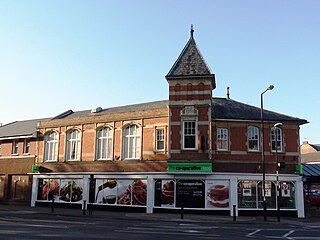
A consumers' co-operative is an enterprise owned by consumers and managed democratically and that aims at fulfilling the needs and aspirations of its members. Such co-operatives operate within the market system, independently of the state, as a form of mutual aid, oriented toward service rather than pecuniary profit. Many cooperatives, however, do have a degree of profit orientation. Just like other corporations, some cooperatives issue dividends to owners based on a share of total net profit or earnings ; or based on a percentage of the total amount of purchases made by the owner. Regardless of whether they issue a dividend or not, most consumers’ cooperatives will offer owners discounts and preferential access to good and services.
A food cooperative or food co-op is a food distribution outlet organized as a cooperative, rather than a private or public company. Food cooperatives are usually consumer cooperatives, where the decisions regarding the production and distribution of its food are chosen by its members. Like all cooperatives, food cooperatives are often based on the 7 Rochdale Principles, and they typically offer natural foods. Decisions about how to run a cooperative are not made by outside shareholders, therefore cooperatives often exhibit a higher degree of social responsibility than their corporate analogues.

Rochdale Village is a housing cooperative and neighborhood in the southeastern corner of the New York City borough of Queens. Located in Community District 12, Rochdale Village is grouped as part of Greater Jamaica, corresponding to the former Town of Jamaica. It is adjacent to four other Queens neighborhoods: St. Albans to the east, South Jamaica to the west, Locust Manor to the north, and Springfield Gardens to the south across the Belt Parkway. Rochdale is about 2 miles (3.2 km) from the Queens/Nassau border and about 1 mile (1.6 km) north of John F. Kennedy International Airport.

Parkfairfax is a neighborhood in Alexandria, Virginia, United States, located in the northwestern part of the city near the boundary with Arlington County. Nearby thoroughfares are Interstate 395, State Route 402, and West Glebe Road.
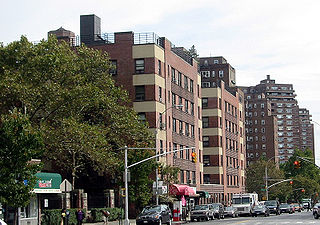
Cooperative Village is a community of housing cooperatives on the Lower East Side of Manhattan, New York City. The cooperatives are centered on Grand Street in an area south of the entrance ramp to the Williamsburg Bridge and west of the FDR Drive. Combined, the four cooperatives have 4,500 apartments in twelve buildings.

The Riverton Houses is a large residential development in Harlem, Manhattan, New York City.

Penn South, officially known as Mutual Redevelopment Houses and formerly Penn Station South, is a limited-equity housing cooperative development located between Eighth and Ninth Avenues and West 23rd and 29th Streets, in the Chelsea neighborhood of Manhattan in New York City. The complex has 2,820 units in ten 22-story buildings. Penn South is so named because of its location southwest of New York Penn Station.
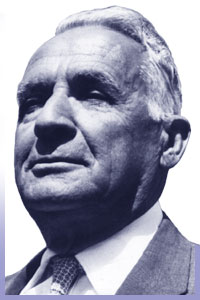
Abraham E. Kazan (1889–1971) is considered the "father of U.S. cooperative housing".
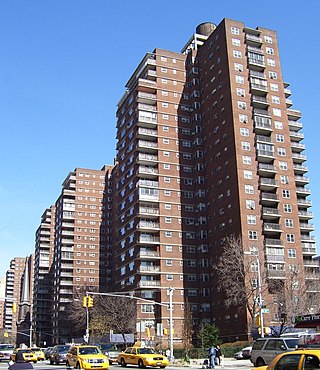
Herman J. Jessor was an American architect who helped build more than 40,000 units of cooperative housing in New York City. He, along with Abraham Kazan, was a driving force of the cooperative housing movement in the United States.
Van Cortlandt Village is a subsection of the Kingsbridge neighborhood in the New York City borough of the Bronx. The neighborhood is part of Bronx Community Board 8. Named after Van Cortlandt Park, it is bordered by the Major Deegan Expressway to the west, the Jerome Park Reservoir to the east, West 238th Street to the south, and Van Cortlandt Park to the north. Its ZIP Code is 10463.
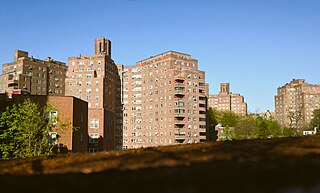
The Amalgamated Housing Cooperative is a pioneering limited-equity cooperative in New York City. Organized by the Amalgamated Clothing Workers (ACW), a Manhattan-based socialist labor union, the co-op's original cluster of Tudor-style buildings was erected at the southern edge of Van Cortlandt Park in 1927. Additional buildings were added in the post-World War II period, and in the 1970s.
York Center is an unincorporated community in York Township, DuPage County, Illinois, United States. York Center is located by Meyers Road and 16th Street, near the southern border of Lombard, and the western border of Oakbrook Terrace. York Center has an elementary school, established in 1958, and a fire protection district, which covers unincorporated areas of Lombard, Villa Park, Oak Brook, and Oakbrook Terrace.
Marcus Garvey Village, also known as Marcus Garvey Apartments, is a 625-unit affordable housing development located in the Brownsville neighborhood of Brooklyn. The complex was developed by the New York State Urban Development Corporation and designed by British architect Kenneth Frampton in 1973 and completed in 1976. In 2016,Michael Kirchmann of GDSNY completed a substantial renovation of the buildings and site. It consists of multiple four-story townhouse-like structures spread across nine city blocks with stoops, private backyards, and semi-public courtyards.
References
- 1 2 Eisenstadt, Peter (2010). Rochdale Village: Robert Moses, 6,000 Families, and New York City's Graet Experiment in Integrated Housing. Ithaca: Cornell University Press.
- ↑ Rodriguez, Sarah. "Penn South: 50 Years of Affordable Housing". Cornell University ILR School. Cornell University. Retrieved 30 December 2022.
- ↑ American Cultural Express: "Cooperative Housing in the New York Region" Archived 2007-09-29 at the Wayback Machine
- ↑ "Guide to the United Housing Foundation Files". rmc.library.cornell.edu. Cornell University. Retrieved 31 December 2022.